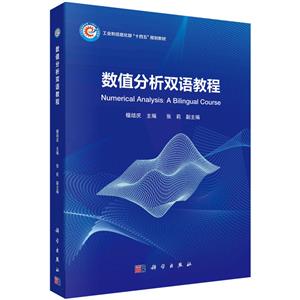预估到手价是按参与促销活动、以最优惠的购买方案计算出的价格(不含优惠券部分),仅供参考,未必等同于实际到手价。
-
>
中医基础理论
-
>
高校军事课教程
-
>
毛泽东思想和中国特色社会主义理论体系概论(2021年版)
-
>
中医内科学·全国中医药行业高等教育“十四五”规划教材
-
>
中医诊断学--新世纪第五版
-
>
中药学·全国中医药行业高等教育“十四五”规划教材
-
>
中医外科学——全国中医药行业高等教育“十四五”规划教材
数值分析双语教程 版权信息
- ISBN:9787030763310
- 条形码:9787030763310 ; 978-7-03-076331-0
- 装帧:平装胶订
- 册数:暂无
- 重量:暂无
- 所属分类:>
数值分析双语教程 内容简介
**章为数学英语和数学基础知识,主要内容包括:常见数学公式和数学表达式的读法、微积分基本概念和主要定理回顾、绝对误差与相对误差的概念等;第二章为求解线性方程组的直接方法,主要内容包括:Gauss消去法、主元法、矩阵分解法、特殊矩阵等;第三章为矩阵代数迭代技术,主要内容包括:Jacobi迭代法、Gauss-Seidel迭代法、SOR迭代法、收敛性分析、条件数、迭代优化等;第四章为一元方程求根,主要内容包括:二分法、不动点迭代、牛顿法、割线法、收敛阶分析等;第五章为多项式插值,主要内容包括:Lagrange插值、Neville插值、Newton插值、Hermite插值、三次样条插值等;第六章为逼近论,主要内容包括:离散*小二乘逼近、正交多项式、*小平方逼近、Chebyshev多项式与幂级数约化等;第七章为数值微分与数值积分,主要内容包括:数值微分、Richardson外推、数值积分、复化数值积分、Romberg积分、Gauss求积等;第八章为常微分方程初值问题,主要内容包括:初值问题基本理论、Euler方法、Runge-Kutta方法、多步方法等。
数值分析双语教程 目录
- >
经典常谈
经典常谈
¥17.1¥39.8 - >
【精装绘本】画给孩子的中国神话
【精装绘本】画给孩子的中国神话
¥17.6¥55.0 - >
名家带你读鲁迅:故事新编
名家带你读鲁迅:故事新编
¥13.0¥26.0 - >
罗庸西南联大授课录
罗庸西南联大授课录
¥13.8¥32.0 - >
自卑与超越
自卑与超越
¥17.1¥39.8 - >
唐代进士录
唐代进士录
¥17.1¥39.8 - >
月亮虎
月亮虎
¥15.4¥48.0 - >
二体千字文
二体千字文
¥16.0¥40.0
-
那时 书妆-百花小开本散文书衣
¥29.3¥38 -
北大人文课(平装)
¥14.4¥45 -
北大哲学课(平装)
¥14.4¥45 -
家居设计解剖书
¥27.3¥39 -
中医基础理论
¥40.6¥58 -
(平装)北大必修课:北大口才课
¥14.4¥45



















